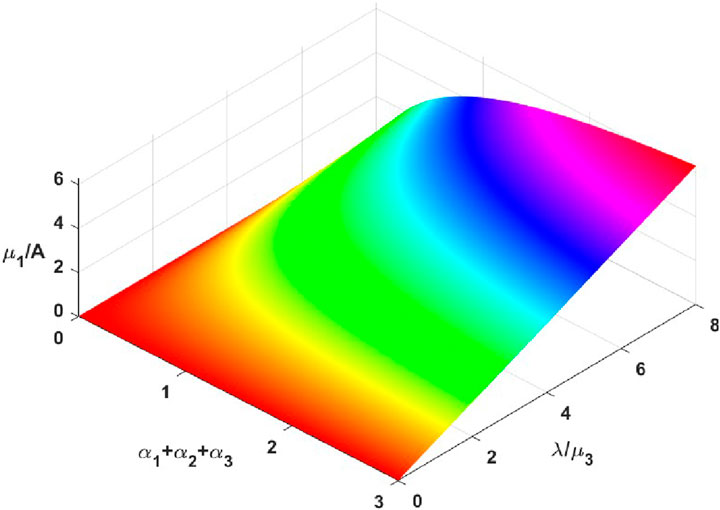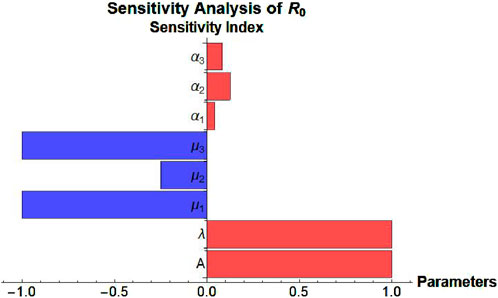- Department of Mathematics Engineering, Faculty of Science and Letters, Istanbul Technical University, Istanbul, Türkiye
Introduction: Public opinion dynamics shape societal discourse, with engagement levels influencing the balance between polarization and depolarization.
Methods: We present a compartmental model inspired by epidemiology to analyze opinion dissemination under external interventions. The model categorizes individuals into susceptible, exposed, positive, negative, and mixed-emotion communicators, with a time-dependent step function
Results: Our analysis focuses specifically on the effects of temporary interventions rather than long-term system evolution. The results highlight engagement as a key control mechanism in shaping ideological stability.
Discussion: Real-world interventions, such as government-imposed access restrictions, demonstrate how targeted engagement shifts influence public discourse. This study provides a mathematical framework for understanding how external interventions drive opinion evolution and offers insights into managing polarization in digital and social environments.
1 Introduction
Opinion dynamics models provide a mathematical framework for understanding how individuals in a population form, spread, and modify their opinions over time. Traditionally studied in social sciences, the formation and evolution of opinions have increasingly attracted interest from researchers in physics, mathematics, and computer science [3]. A variety of works focuses on constructing mathematical models of opinion dynamics, using tools from statistical physics, network theory as well as computational modeling [1, 2, 14, 15, 17, 20, 26, 34].
Several well-known opinion models have been proposed to describe different mechanisms of opinion evolution. One of the foundational models in this field is the Deffuant-Weisbuch model, which describes how individuals adjust their opinions through pairwise interactions, with convergence occurring only if their initial opinions are close enough [6]. Similarly, the Hegselmann-Krause model assumes that individuals update their opinions based on a weighted average of those within a specified confidence threshold [13], capturing how opinion fragmentation and clustering arise from selective interactions. Expanding on these ideas, bounded confidence models [21] further explore the role of echo chambers in social networks, where individuals tend to reinforce their pre-existing beliefs by selectively interacting with like-minded peers.Other important frameworks include the voter model, which captures opinion shifts through random imitation of neighbors [29], and Ising-type models that represent opinion dynamics as binary-state systems influenced by local alignment and noise, drawing inspiration from statistical physics [29].
Beyond these foundational models, numerous alternative approaches have been developed, utilizing a wide range of modeling techniques. One widely used strategy is agent-based modeling (ABM), which allows for rich micro-level realism by simulating individuals as autonomous entities interacting based on heterogeneous rules [3, 19, 23, 28]. However, complex ABMs can be difficult to initialize and parameterize [30], are often criticized for lack of transparency and difficulty in evaluation [24], and may generate high-dimensional output that is hard to interpret [16].
Alongside these approaches, epidemic-inspired frameworks have also been widely used to study opinion spread, leveraging their ability to describe diffusion processes in a manner analogous to disease transmission [5, 12]. Studies proposed adaptations of Susceptible-Infected-Recovered (SIR) models to opinion spread, emphasizing similarities between rumor transmission and epidemic propagation [5, 32, 33, 35, 36]. Additionally, Susceptible-Exposed-Infected-Recovered (SEIR) models have also been used to capture the dynamics of opinion evolution, incorporating factors such as sentiment-driven interactions, decision-making processes, and multilingual opinion transfer [4, 8, 9, 22, 28, 37].
Building on this analytical advantage, we adopt and extend the recent compartmental framework introduced by Geng et al. [11], which is itself inspired by epidemic modeling structures. A key innovation in our study is the inclusion of a Mixed-Emotion Compartment
In many socio-political and ideological debates, individuals rarely adhere strictly to a single stance; rather, they endorse some aspects of a discussion while opposing others. Classical models categorize individuals into predefined states—such as neutral, positive, or negative—but fail to capture those who actively engage in discourse while disseminating mixed sentiments. These individuals shape discussions in multiple directions rather than reinforcing a single stance, as seen in political debates, where people may support aspects of a reform while rejecting others. To address this, we introduce the Mixed-Emotion Compartment
The remainder of this paper is structured as follows: In Section 2, we introduce the mathematical model for online public opinion dynamics, establish the positivity and boundedness of solutions, and determine the equilibrium points. Section 3 presents the stability analysis, where we derive the basic reproduction number, analyze the local and global asymptotic properties of the equilibrium points, and illustrate the results. Finally, in Section 4, we discuss our findings in the context of real-world social media discourse and suggest possible extensions to the model.
2 Modeling online public opinion dynamics: positive, negative, and mixed emotions under media interventions
2.1 Mathematical model
To analyze the dynamics of opinion dissemination under media interventions, we propose a compartmental model inspired by epidemiological frameworks. The model classifies the population into five compartments, where
The governing equations of our model, presented below, describe the dynamical transitions between opinion states, while the corresponding flow diagram (Figure 1) visually represents these transitions
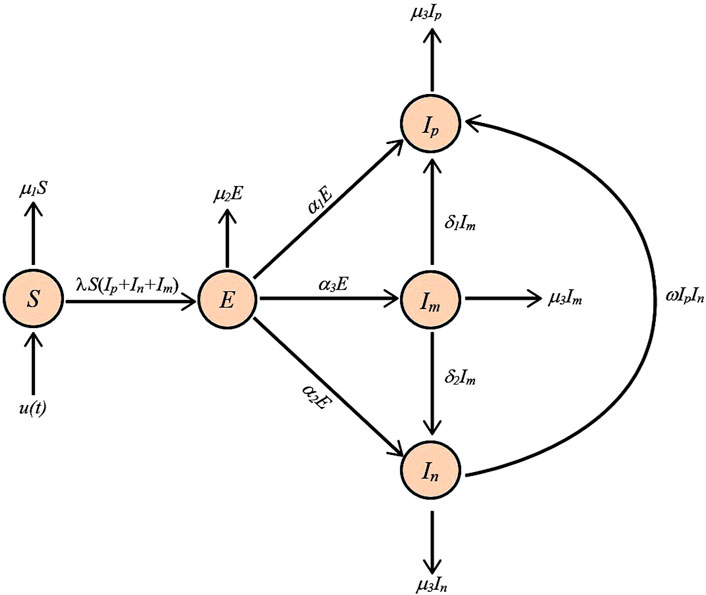
Figure 1. Flow diagram representing the opinion dynamics model in (Equation 1).
We assume that the disengagement rates for positive communicators
In contrast, susceptible
In system (1), each derivative denotes the rate of change with respect to time
Here,
The disengagement probabilities are given by
In our model, the influx of new individuals into the susceptible population is represented by the function
Here,
Engagement surges often arise from external factors such as major news events, viral media cycles, or coordinated platform-wide promotions. These triggers can cause abrupt increases in user participation, temporarily altering the trajectory of public discourse. Our model captures such surges through a time-dependent influx function, allowing for the analysis of how transient or sustained engagement influences long-term opinion dynamics.
2.2 Positivity and boundedness
A fundamental requirement in modeling such systems is ensuring that all state variables remain non-negative and bounded over time. This guarantees that the solutions remain physically meaningful, as negative values would not correspond to realistic interpretations of population sizes. The following theorem demonstrates that the total population remains constrained within a positively invariant region.
Theorem 1. Let
is positively invariant set for the model given in (1).
Proof. To analyze the behavior of the system in (Equation 1), we sum the equations and define the total population as
By introducing
which clearly indicates that
Solving this inequality leads to the conclusion that
providing an upper bound for the total population as
Furthermore, for
Therefore,
2.3 Equlibrium points
Analyzing the equilibrium points of the system provides insight into its long-term behavior. Equilibrium states correspond to points where the system remains unchanged over time, meaning all derivatives are set to zero. By solving the resulting algebraic equations, we can determine steady-state solutions that describe possible stable configurations of the system.
Solving for
By adding the third and fourth equations in (1) and setting the result to zero, we obtain
On the other hand, substituting (Equations 2, 3) into the expression
This equation reveals two possible solutions,
For a nonzero
which is positive for all parameter combinations.
By substituting (Equations 2, 3 and 5) into
The condition for
Then, (Equation 2) gives
Similarly, by substituting (Equations 3, 7) into
where
For positive
which always exists since
which remains positive for all parameter combinations. Thus, there exists the endemic equilibrium point
3 Stability analysis
In this section, we analyze the stability properties of the system by first determining the basic reproduction number. We then examine both the local and global asymptotic stability of both equilibria and establish the conditions for their stability. Finally, we illustrate these theoretical results through numerical simulations.
3.1 Basic reproduction number
The basic reproduction number,
Using the next-generation matrix method and following the notation in [7],
Then, we obtain the basic reproduction number as
3.2 Dissemination-free equilibrium
The dissemination-free equilibrium represents a state where the system reaches stability in the absence of active dissemination. The following theorem provides the conditions for local asymptotic stability.
Theorem 2. For the model defined by (1), the dissemination-free equilibrium is locally asymptotically stable when
Proof. The Jacobian matrix of the nonlinear system (1) is as follows
and the corresponding matrix at the dissemination-free equilibrium is given by
The characteristic equation corresponding to (Equation 11) is
where
If we use the basic reproduction number in (Equation 9), then we can express
Therefore, all eigenvalues of the characteristic equation will have negative real parts if
Theorem 3. The dissemination-free equilibrium,
Proof. We define the following linear Lyapunov function
Considering (1) together with (5), the derivative of the Lyapunov function with respect to
Equation 9 indicates that the final inequality can be expressed as
For
In Figure 2, the system is depicted for the parameter values
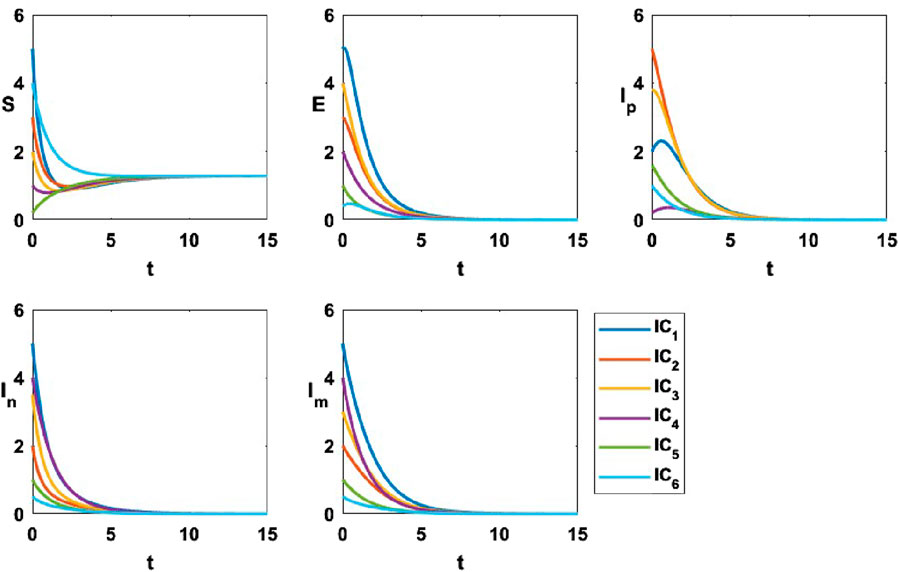
Figure 2. The variational curves of
3.3 Endemic equilibrium
The endemic equilibrium represents a steady-state solution where dissemination persists in the system at a constant level. Analyzing the stability of this equilibrium provides insight into the long-term behavior of the system, helping to identify conditions under which dissemination persists or diminishes over time.
Theorem 4. For the model defined by (1), the endemic equilibrium,
Proof. We define the following coefficients
Then, the characteristic polynomial of the Jacobian matrix (Equation 10) corresponding to
It is evident that
The inequality in (Equation 6) can be reformulated in terms of
This reformulation highlights that the endemic equilibrium is asymptotically stable for
Figure 3 illustrates the surface corresponding to
Theorem 5. The endemic equilibrium,
Proof. We consider a nonlinear Lyapunov function of the Goh–Volterra type, structured as
which is particularly well-suited for systems with nonlinear interactions, such as those observed in biological or ecological models. Here,
Let us define the following Lyapunov function of this type for the model given by (1)
where
By differentiating (Equation 12) and substituting the expressions for the derivatives defined in (1), we obtain
where
where
We set
A small deviation from the steady state, derived from (Equations 1 and 14), leads to
Since the arithmetic mean is greater than or equal to the geometric mean, we get
which implies that
Figure 4 presents the system dynamics, utilizing the parameter values
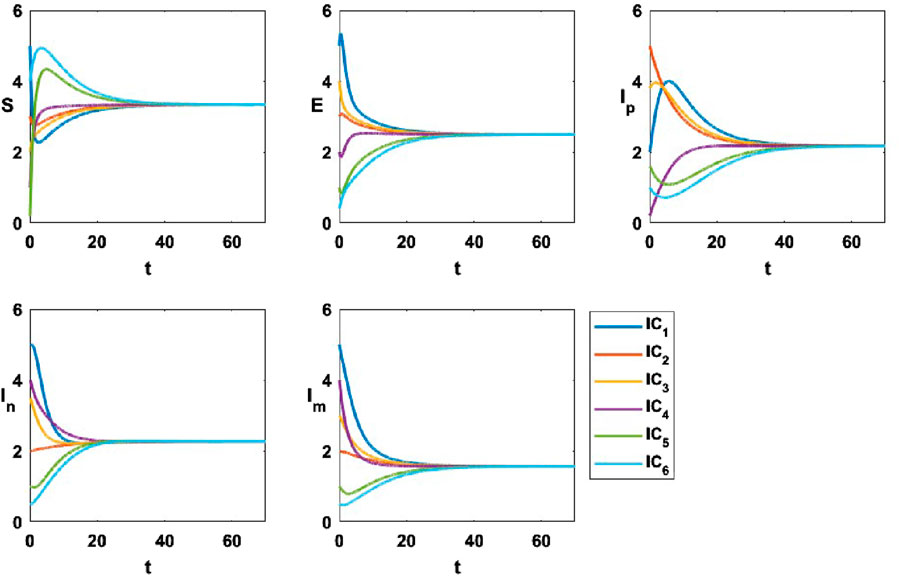
Figure 4. The variational curves of
3.4 Transcritical bifurcation
At
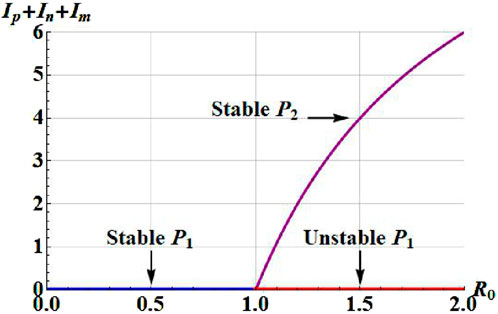
Figure 5. Transcritical bifurcation in the
The graphical representation highlights the following distinct equilibrium branches in the system.
3.5 Simulations
3.5.1 Sensitivity analysis of the basic reproduction number
Understanding the sensitivity of the basic reproduction number
where
Figure 6 presents a bar chart of the sensitivity indices, visually comparing the relative influence of each parameter on
The contour plots in Figure 7 illustrate how
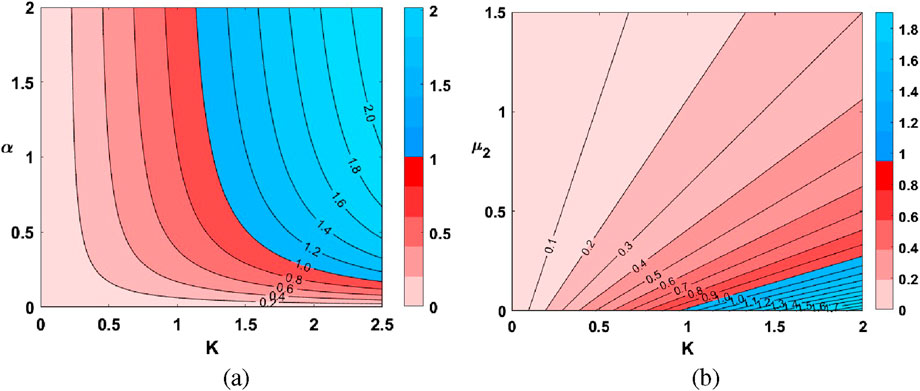
Figure 7. Contour plots of
3.5.2 Role of engagement in driving polarization and depolarization
Although the model formulation permits time-bounded influxes, the following simulations assume a constant
The simulation results, presented in Figure 8, illustrate the influence of 12 different values of
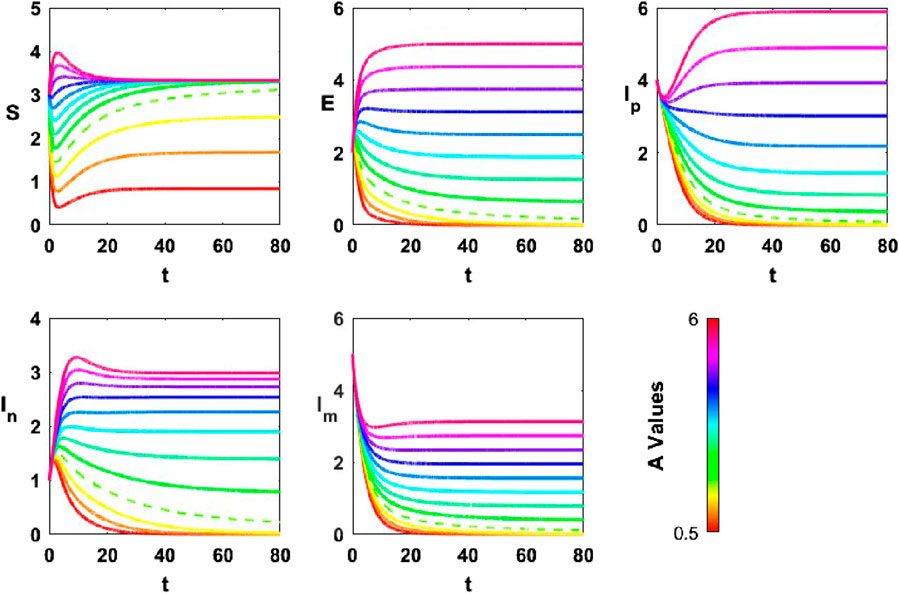
Figure 8. Temporal evolution of opinion groups (
For smaller values of
As
For higher values of
At lower engagement levels, depolarization occurs as both communicator groups gradually lose influence, leading to a more homogeneous opinion landscape. As
Overall, the simulation results suggest that engagement plays a crucial role in shaping the balance between polarization and depolarization. When engagement is high, ideological divisions are reinforced, with both positive and negative opinion groups persisting at substantial levels. In contrast, when engagement is weak, opinion groups lose their influence over time, leading to a more depolarized system where ideological fragmentation is reduced. These observations, based on the chosen parameter values, highlight the potential of engagement as a mechanism that can either sustain ideological divisions or facilitate depolarization, depending on its intensity.
3.5.3 Role of influence rate in driving polarization and depolarization
In this analysis, the engagement level is fixed at
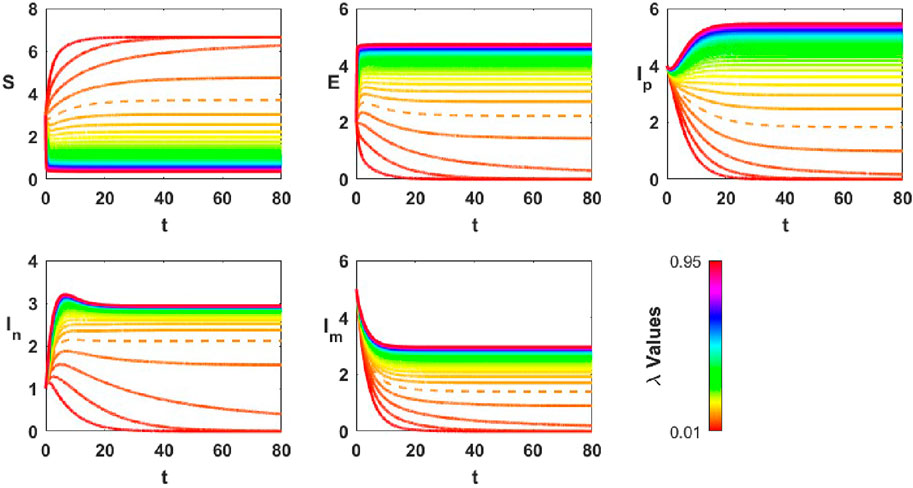
Figure 9. Temporal evolution of opinion groups (
The results suggest that
In accordance with the model’s dynamics, stronger influence increases opinion propagation without ensuring convergence to a single viewpoint.
3.5.4 Role of disengagement rate in driving polarization and depolarization
In this analysis, the disengagement level of susceptibles,
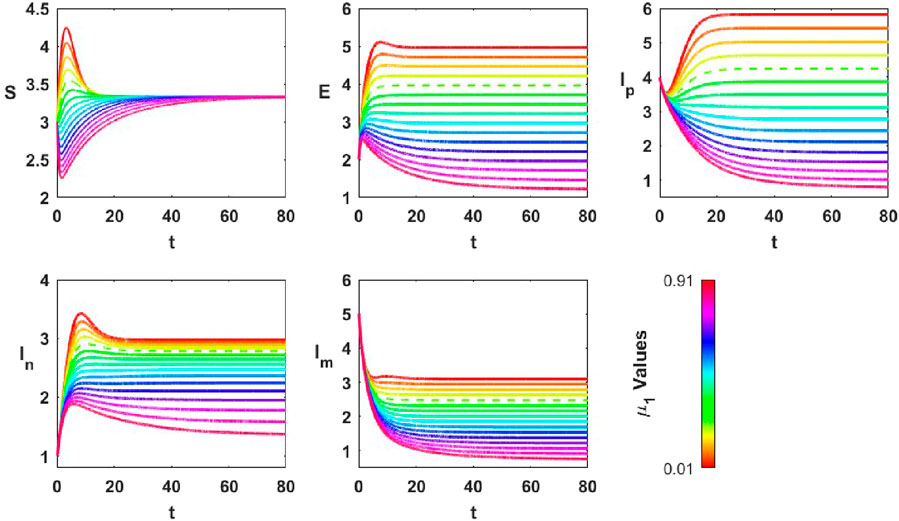
Figure 10. Temporal evolution of opinion groups (
For higher values of
Given the role of
4 Conclusion
In this study, we developed and analyzed a compartmental model that captures the nonlinear dynamics of public opinion dissemination under finite-duration interventions. The model incorporates five interacting compartments, including a novel mixed-emotion group, and is driven by a time-dependent influx function representing external engagement. Through rigorous analytical methods, we established the positivity and boundedness of solutions, identified both dissemination-free and endemic equilibrium points, and determined their stability based on the basic reproduction number
Our findings suggest that public discourse can indeed be influenced through targeted interventions, particularly via parameters that correspond to policy-relevant levers. In our model, the engagement amplitude
A key simplification in our model is the use of constant transition rates from exposed individuals to the opinionated compartments. This implies that opinion adoption is governed by internal dispositions rather than social influence at that stage. While this allows for analytical tractability, it overlooks potential feedback effects where individuals might be more likely to adopt the most visible or dominant opinion. Future extensions could relax this assumption by introducing state-dependent transition rates, possibly influenced by the current distribution of
Taken together, both our simulations and sensitivity analysis show that tuning these parameters can shift the system between polarized and depolarized states, offering a theoretical foundation for understanding how public discourse might be steered through real-world regulatory actions.
Future work may extend the model to incorporate time-dependent transition rates and influx functions, allowing for the study of non-autonomous regimes and temporally structured interventions. In particular, while our formulation admits a general time-bounded influx
Data availability statement
The original contributions presented in the study are included in the article/supplementary material, further inquiries can be directed to the corresponding author.
Author contributions
AD: Writing – original draft, Formal Analysis, Visualization, Methodology, Software, Writing – review and editing, Validation. AP-D: Software, Writing – review and editing, Methodology, Writing – original draft, Conceptualization, Investigation, Visualization, Validation, Formal Analysis. SH: Writing – original draft, Formal Analysis, Methodology, Validation, Investigation, Writing – review and editing.
Funding
The author(s) declare that no financial support was received for the research and/or publication of this article.
Conflict of interest
The authors declare that the research was conducted in the absence of any commercial or financial relationships that could be construed as a potential conflict of interest.
Generative AI statement
The author(s) declare that no Generative AI was used in the creation of this manuscript.
Any alternative text (alt text) provided alongside figures in this article has been generated by Frontiers with the support of artificial intelligence and reasonable efforts have been made to ensure accuracy, including review by the authors wherever possible. If you identify any issues, please contact us.
Publisher’s note
All claims expressed in this article are solely those of the authors and do not necessarily represent those of their affiliated organizations, or those of the publisher, the editors and the reviewers. Any product that may be evaluated in this article, or claim that may be made by its manufacturer, is not guaranteed or endorsed by the publisher.
References
1. Ataş F, Demirci A, Özemir C. Bifurcation analysis of friedkin–johnsen and hegselmann–krause models with a nonlinear interaction potential. Mathematics Comput Simulation (2021) 185:676–86. doi:10.1016/j.matcom.2021.01.012
2. Baumann F, Lorenz-Spreen P, Sokolov IM, Starnini M. Modeling echo chambers and polarization dynamics in social networks. Phys Rev Lett (2020) 124:048301. doi:10.1103/physrevlett.124.048301
3. Castellano C, Fortunato S, Loreto V. Statistical physics of social dynamics. Rev Mod Phys (2009) 81:591–646. doi:10.1103/RevModPhys.81.591
4. Chen X, Liu Q, Zhang M, Yang Z. Dynamical interplay between the dissemination of scientific knowledge and rumor spreading in emergency. Physica A: Stat Mech its Appl (2019) 526:120808. doi:10.1016/j.physa.2019.120808
6. Deffuant G, Neau D, Amblard F, Weisbuch G. Mixing beliefs among interacting agents. Adv Complex Syst (2000) 3:87–98. doi:10.1142/S0219525900000078
7. Diekmann O, Heesterbeek JAP, Roberts MG. The construction of next-generation matrices for compartmental epidemic models. J R Soc Interf (2010) 7:873–85. doi:10.1098/rsif.2009.0386
8. Dong S, Wang H, Zhao Y, Wei J, Zhang X. Multilingual seir public opinion propagation model with social enhancement mechanism and cross transmission mechanisms. Scientific Rep (2024) 14:82024. doi:10.1038/s41598-024-82024-3
9. Fang M, Li L-N, Yang L. Social network public opinion research based on s-seir epidemic model. In: 2019 IEEE international conference on cloud computing technology and science (CloudCom). IEEE (2019). p. 374–9. doi:10.1109/CloudCom.2019.00069
10. Galston WA. Political knowledge, political engagement, and civic education. Annu Rev Polit Sci (2001) 4:217–34. doi:10.1146/annurev.polisci.4.1.217
11. Geng L, He Y, Tang L, Chen W, Wang K. Online public opinion dissemination model and simulation under media intervention from different perspectives. Chaos, Solitons and Fractals (2023) 166:112959. doi:10.1016/j.chaos.2022.112959
12. Goffman W, Newill V. Generalization of epidemic theory: an application to the transmission of ideas. Nature (1964) 204:225–8. doi:10.1038/204225a0
13. Hegselmann R, Krause U. Opinion dynamics and bounded confidence: models, analysis and simulation. J Artif Societies Social Simulation (2002) 5. doi:10.18564/jasss.372
14. Ishii A, Okano N, Nishikawa M. Social simulation of intergroup conflicts using a new model of opinion dynamics. Front Phys (2021) 9:640925. doi:10.3389/fphy.2021.640925
15. Laguna MF, Risau Gusman S, Abramson G, Gonçalves S, Iglesias JR. The dynamics of opinion in hierarchical organizations. Physica A: Stat Mech its Appl (2005) 351:580–92. doi:10.1016/j.physa.2004.11.064
16. Lee J-SF, Tatiana LZ, Arika HM, Behrooz S, Forrest L, Iris V, et al. (2015). The complexities of agent-based modeling output analysis. J Artif Soc S 18. 4. doi:10.18564/jasss.2897
17. Lee W, Yang S-G, Kim BJ. The effect of media on opinion formation. Physica A: Stat Mech its Appl (2022) 595:127075. doi:10.1016/j.physa.2022.127075
18. Li J, Liu Y, Wang X, Zhao Q. Mechanism study of social media overload on health self-efficacy and anxiety. Heliyon (2024) 10:e1277846. doi:10.1016/j.heliyon.2024.e1277846
19. Li L, Li Y, Zhang J. Fractional-order sir model for predicting public opinion dissemination in social networks. Eng Lett (2023) 31.
20. Lorenz J. Continuous opinion dynamics under bounded confidence: a survey. Int J Mod Phys C (2007) 18:1819–38. doi:10.1142/S0129183107011789
21. Lorenz J. Repeated averaging and bounded confidence modeling, analysis and simulation of continuous opinion dynamics. Universität Bremen (2007). Ph.D. thesis.
22. Lv Y, Wang Z, Zhang H, Zhang X. Research on panic spread and decision behavior in a delayed seir evolutionary game model under an emergency. Scientific Rep (2023) 13: 44116. doi:10.1038/s41598-023-44116-4
23. Macal CM, North MJ. “Tutorial on agent-based modeling and simulation,” in Proceedings of the Winter Simulation Conference, 2005. (IEEE). 14. doi:10.1109/WSC.2005.1574234
24. Müller B, Balbi S. Standardized and transparent model descriptions for agent-based models: current status and prospects. Environ Model and Softw (2014) 55:156–63. doi:10.1016/j.envsoft.2014.01.029
25. Pang X, Zhang Y, Li X, Wang H. How differential dimensions of social media overload influence fatigue: an empirical study during the covid-19 pandemic. Int J Environ Res Public Health (2023) 20:9818937. doi:10.3390/ijerph20031893
26. Pranesh S, Gupta S. Exploring cognitive inertia in opinion dynamics using an activity-driven model. Chaos, Solitons and Fractals (2025) 191:115879. doi:10.1016/j.chaos.2024.115879
27. Qin X, Wu Z, Chen L, Zhang H. The impact of social media fatigue on disengagement: evidence from digital discourse analysis. Front Psychol (2024) 15:1277846. doi:10.3389/fpsyg.2024.1277846
28. Qin Z, Li S, Qi H, Liu S, Meng G, Luo M. Analyze and solve the network public opinion communication based on the improved seir model. 3rd Int Conf Appl Math Model Intell Comput (CAMMIC 2023) (Spie) (2023) 12756:1101–12. doi:10.1117/12.2685942
30. Smajgl A, Barreteau O. Empirical calibration of agent-based models–challenges and approaches (2014). Springer1. doi:10.1007/978-1-4614-6134-0
31. Taylor SE. Decision fatigue and cognitive overload in public engagement. J Cogn Psychol (2021) 33:515–30. doi:10.1080/20445911.2021.1942103
32. Wang X, Lin X, Zhong X, Zhang Y, Qiu C. A rumor reversal model of online health information during the covid-19 epidemic. Inf Process and Management (2021) 58:102731. doi:10.1016/j.ipm.2021.102731
33. Woo J, Son J, Chen H. An sir model for violent topic diffusion in social media. In: Proceedings of 2011 IEEE international conference on intelligence and security informatics (2011). p. 15–9. doi:10.1109/ISI.2011.5984043
34. Xia H, Huili W, Zhaoguo X. Opinion dynamics: a multidisciplinary review and perspective on future research. Int J Knowledge Syst Sci (Ijkss) (2011) 2:72–91. doi:10.4018/jkss.2011100106
35. Yan Z, Zhou X, Du R. An enhanced sir dynamic model: the timing and changes in public opinion in the process of information diffusion. Electron Commerce Res (2024) 24:2021–44. doi:10.1007/s10660-022-09608-x
36. Yuan J, Shi J, Wang J, Liu W. Modelling network public opinion polarization based on sir model considering dynamic network structure. Alexandria Eng J (2022) 61:4557–71. doi:10.1016/j.aej.2021.10.014
Keywords: polarization, epidemic models, opinion dynamics, bifurcation, stability
Citation: Demirci A, Peker-Dobie A and Harman S (2025) Modeling opinion polarization: can we control public discourse?. Front. Phys. 13:1626026. doi: 10.3389/fphy.2025.1626026
Received: 09 May 2025; Accepted: 13 August 2025;
Published: 02 September 2025.
Edited by:
Valerio Restocchi, University of Edinburgh, United KingdomReviewed by:
Maria Letizia Bertotti, Free University of Bozen-Bolzano, ItalySayan Gupta, Indian Institute of Technology Madras, India
Guillermo Romero Moreno, Centrum Wiskunde & Informatica, Netherlands
Copyright © 2025 Demirci, Peker-Dobie and Harman. This is an open-access article distributed under the terms of the Creative Commons Attribution License (CC BY). The use, distribution or reproduction in other forums is permitted, provided the original author(s) and the copyright owner(s) are credited and that the original publication in this journal is cited, in accordance with accepted academic practice. No use, distribution or reproduction is permitted which does not comply with these terms.
*Correspondence: Ayse Peker-Dobie, cGRvYmllQGl0dS5lZHUudHI=
 Ali Demirci
Ali Demirci Ayse Peker-Dobie
Ayse Peker-Dobie Sevgi Harman
Sevgi Harman